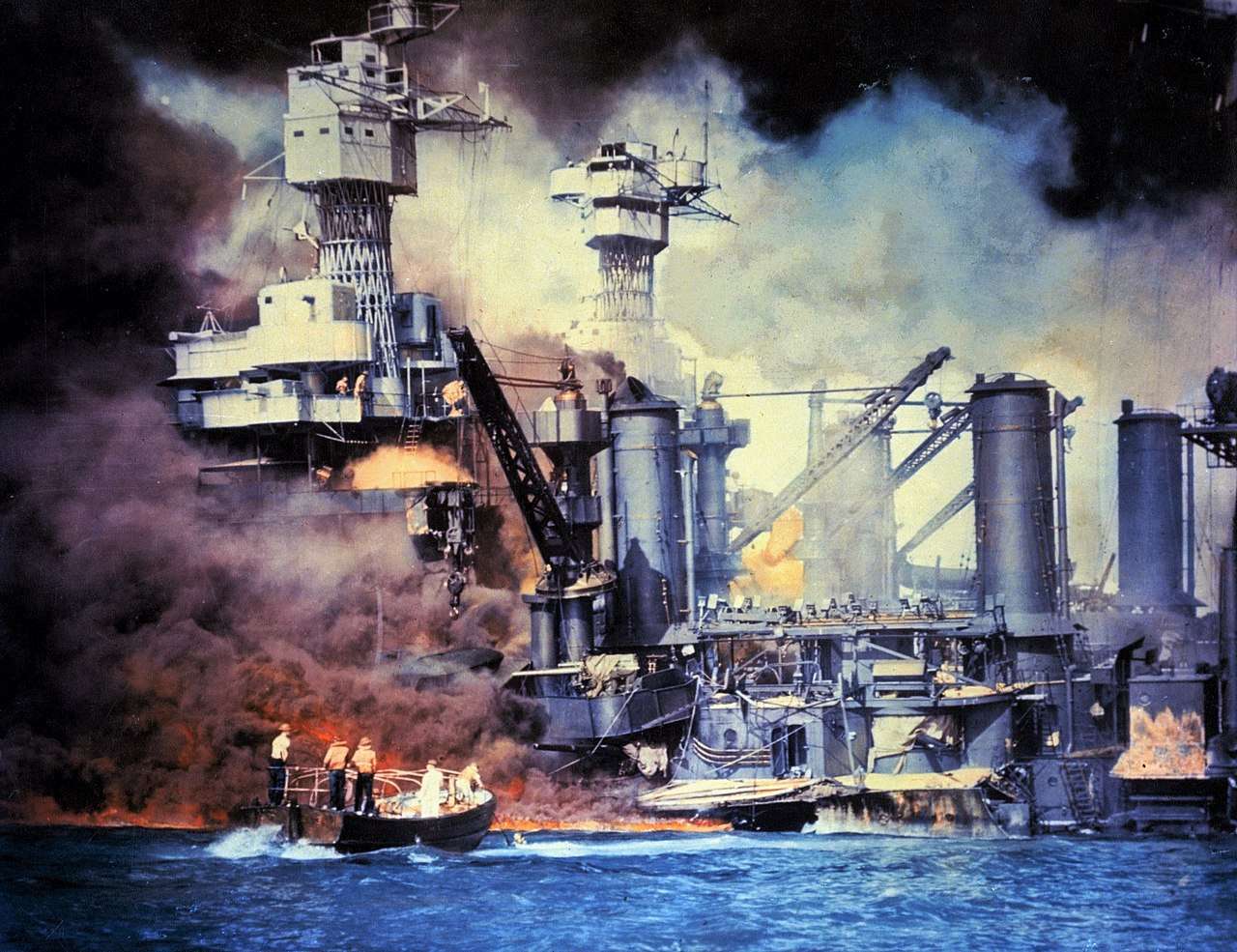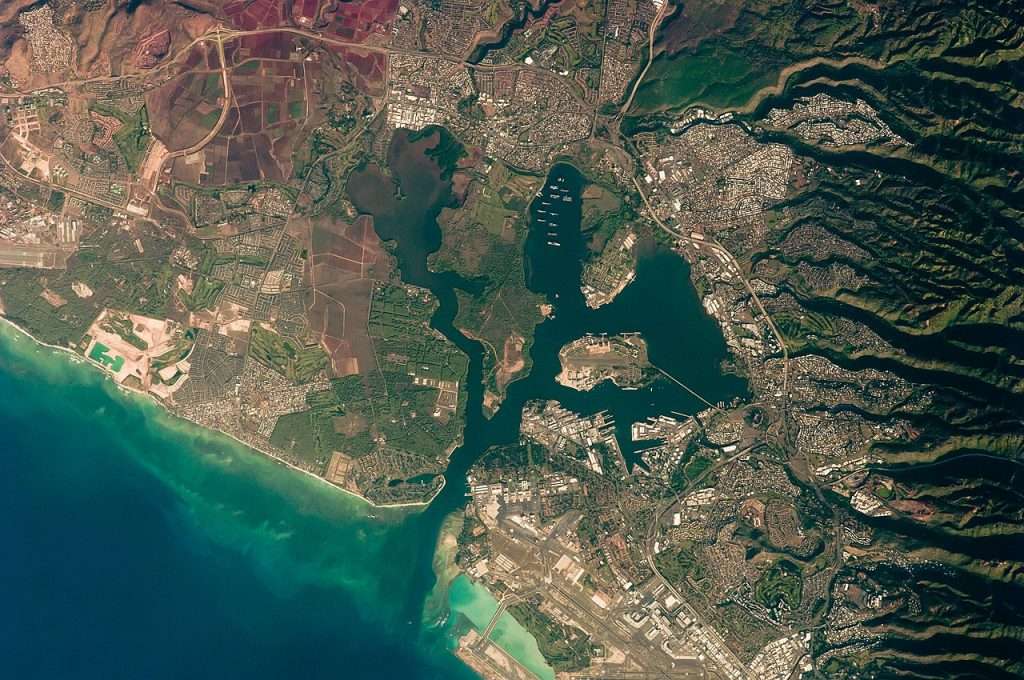Pearl Harbor, located on the island of Oahu in Hawaii, holds a pivotal place in both Hawaiian and American histories.

Although now inextricably linked with the tragic events of December 7, 1941, the harbor’s significance stretches back centuries, long before the aerial assault that would plunge the United States into World War II.
Ancient Significance Of Pearl Harbor
Pearl Harbor’s roots, before its notoriety in modern history, are deeply entrenched in the rich tapestry of the native Hawaiian culture.
Known as “Wai Momi” to the indigenous population, the name translates to “waters of pearl.”
This wasn’t just a poetic reflection of its pristine waters, but a literal testament to the vast quantities of pearls that once bedecked its depths.
These pearls were not just mineral formations but were symbolic treasures, representing wealth, status, and the bounty of the sea.
The natural topography of the harbor made it a haven for ancient Hawaiians. Its deep waters, shielded from the onslaught of the open Pacific, provided a sanctuary against tumultuous seas and storms.
For early navigators and fishermen, Pearl Harbor was a vital safe haven, allowing them to anchor their canoes and gather, making it a communal space for trading, meeting, and socializing.
 Southern Coast of Oahu, Hawaiian Islands, including Pearl Harbor.
Southern Coast of Oahu, Hawaiian Islands, including Pearl Harbor.
Moreover, the surrounding environs of the harbor teemed with life. The wetlands and shores were bountiful, providing the early settlers with ample fish, shellfish, and aquatic plants essential for sustenance.
Spiritually, waters like those of Wai Momi were seen as a connection between the physical world and the realm of the gods.
The presence of pearls, their shimmering beauty emerging from the depths, only added to the mystique of the place, making it not just a geographical location, but a sacred space where nature and divinity coalesced.
In essence, long before the smoke of war blurred its skies or modern developments lined its shores, Pearl Harbor was a place of life, sustenance, and spiritual significance for the Hawaiian people.
Western Contact And The 19th Century
The Western world’s introduction to Pearl Harbor marked the beginning of an era that would drastically reshape the cultural and political landscape of Hawaii.
The harbor’s natural attributes had long been recognized and revered by the indigenous Hawaiians, but its potential significance in global geopolitics was yet to be fully realized.
Captain James King, who first set eyes on the harbor in 1793, followed in the footsteps of his predecessor, Captain James Cook, in chronicling new territories for the British Empire.
Although Cook never lived to witness Pearl Harbor, King’s recorded visit symbolized the West’s increasing interest in the Pacific islands, a region previously seen as remote and inaccessible.
However, the initial encounters were just precursors to more intensive Western interests. By the 19th century, as maritime trade routes expanded and the global competition for colonial territories intensified, the strategic importance of locations like Pearl Harbor grew evident.
The harbor’s deep, protected waters offered an ideal anchorage point for vessels, making it invaluable for an era dominated by naval power and maritime trade.
 An image taken of Pearl Harbor in the 1880s.
An image taken of Pearl Harbor in the 1880s.
Whaling, a significant industry in the 19th century, saw American ships venturing deep into the Pacific. For these long voyages, Pearl Harbor presented itself as a valuable respite and refueling point.
With the United States’ increasing involvement in Pacific maritime activities, it became crucial to forge formal agreements with the Hawaiian monarchy.
This came in the form of the Reciprocity Treaty of 1875. Beyond the trade advantages it offered, this treaty permitted the establishment of a coal station at Pearl Harbor. Such a station was not merely a refueling point but symbolized the United States’ growing footprint in the region.
The harbor’s growing strategic value was cemented further towards the end of the 19th century. The 1893 overthrow of the Hawaiian monarchy by a coalition of American and European businessmen, backed by the U.S. military, was a stark demonstration of the West’s ambitions in Hawaii.
Pearl Harbor, by virtue of its location and attributes, was central to these designs. This sentiment was formalized in 1898 when Hawaii was annexed by the U.S., turning Pearl Harbor into a key asset in America’s Pacific defense and strategy.
Modern Military Significance
As the world entered the 20th century, an era characterized by rapidly evolving military technologies, global power shifts, and brewing tensions, Pearl Harbor’s significance on the world stage became increasingly magnified.
The harbor, once a tranquil locale rich in natural resources, evolved into a nexus of American military might in the Pacific.
The early 20th century witnessed a reconfiguration of global power dynamics. Empires in Europe were jostling for dominance, and the Pacific became the next frontier in this imperial chess game.
Simultaneously, the Asian theater, particularly Japan, was witnessing a rise in militarization and expansionist ambitions.
Given this backdrop, the United States recognized that its interests in Asia and the Pacific needed protection.
Pearl Harbor, with its strategic position in the center of the Pacific, was ideally placed to project power and offer defense.
Recognizing this potential, the U.S. made significant investments in fortifying Pearl Harbor in the early 1900s. The construction of a state-of-the-art dry dock was not just a technical marvel but symbolized the harbor’s transformation into a forefront naval installation. The harbor then began to house the Pacific Fleet.
Pearl Harbor also became an epicenter for naval training, logistics, and intelligence. As tensions mounted globally, especially with the rise of Japan as a formidable naval power, the harbor played a crucial role in monitoring activities in the Pacific, ensuring that America was never caught off guard.
However, the tragic events of December 7, 1941, when Japanese aircraft launched a surprise attack, demonstrated that even such a fortified bastion had vulnerabilities.
December 7, 1941
December 7, 1941, stands out as a day of profound shock and change, not just for the people of Pearl Harbor, but for the entire United States and the course of world history.
On this fateful morning, a sudden and unanticipated attack by Japanese forces shifted the narrative of World War II and dramatically altered global geopolitics.
At dawn, Pearl Harbor presented the picture of a regular day, with ships docked in a seemingly impregnable fortress, soldiers going about their routines, and aircraft standing ready.
However, the calm was violently shattered as waves of Japanese aircraft descended from the skies. With surgical precision and overwhelming force, they targeted battleships, cruisers, destroyers, and airfields.
The attack was meticulously planned and executed. Using aircraft carriers positioned northwest of Hawaii, the Japanese launched their aircraft in two waves.
The objective was clear: incapacitate the Pacific Fleet and buy Japan the time it needed to solidify its positions in Southeast Asia without interference from the United States.
 USS Arizona during the attack.
USS Arizona during the attack.
And to a large extent, the attack achieved its tactical goals. The USS Arizona was decimated, with over 1,100 of her crew tragically losing their lives.
In total, 19 ships were sunk or critically damaged, and nearly 200 aircraft were destroyed on the ground. The human cost was even more devastating, with over 2,400 Americans killed and 1,000 more injured.
However, beyond the destruction, December 7 carried deeper implications. The assault was not merely a military strike; it was a blow to American pride, security, and the notion of invulnerability.
The United States, which had so far been hesitant about entering the global conflict, now found its isolationist stance untenable.
The attack galvanized the nation, transforming public opinion from one of non-intervention to a collective cry for action.
As President Franklin D. Roosevelt addressed the nation and described the event as “a date which will live in infamy,” Congress declared war on Japan, marking the United States’ formal entry into World War II.
The subsequent mobilization of American industry, manpower, and resources turned the tide of the war in favor of the Allies. Pearl Harbor, though deeply scarred, would rebuild and play a crucial role in this endeavor.
The Pacific theater saw intense combat, and the harbor became a launching pad for many key operations against Japanese-held territories.
Post-War Period And Present Day
The end of World War II in 1945 marked a new beginning for many regions across the globe, and Pearl Harbor was no exception.
Emerging from the devastation and loss experienced during the surprise attack by the Japanese and the subsequent years of intense warfare, the harbor began a journey of transformation.
Immediately after the war, Pearl Harbor remained a bustling military hub. The Cold War era, characterized by the ideological standoff between the United States and the Soviet Union, necessitated a strong American military presence in the Pacific.
This ensured that the harbor retained its strategic importance, continuing to house a significant portion of the U.S. Pacific Fleet and serving as a logistical and command center.
However, parallel to its military role, Pearl Harbor started evolving as a site of memory and reflection.
The haunting remnants of the attack, particularly the sunken USS Arizona, became poignant reminders of the lives lost on that fateful December morning.
In 1962, the USS Arizona Memorial was dedicated, serving as a solemn space for visitors to pay their respects and learn about the events of December 7, 1941.
Over the years, it has grown to become one of Hawaii’s most visited sites, drawing millions from around the world.
As decades passed, the international animosities of the World War II era began to fade, making way for diplomacy and reconciliation.
The once-adversarial relationship between the U.S. and Japan transformed into one of mutual respect and cooperation.
Pearl Harbor played a symbolic role in this healing process. The harbor, once a site of conflict and pain, has hosted various bilateral events and ceremonies, where leaders and veterans from both nations have come together to remember the past and pledge peace for the future.
 Warships at Pearl Harbor during the RIMPAC exercises in 2004.
Warships at Pearl Harbor during the RIMPAC exercises in 2004.
Today, Pearl Harbor stands as a multi-dimensional entity. Its military significance remains, with the harbor continuing to be an essential component of U.S. defense strategies in the Pacific.
But perhaps more importantly, it serves as a bridge between past and present, offering lessons in resilience, reconciliation, and the high costs of war.
News
Miley Cyrus N-de & S*xy Collection (10 Photos)
Miley Cyrus, the American Fappening celeb, is in a new set of nude and sexy pics, showin’ off her stuff! Instagram: https://www.instagram.com/mileycyrus/
Exactly 6 years ago, Taylor Swift’s “MV that made the audience talk a lot” Delicate was released globally.
After exactly 1 year and 4 months of release, Taylor Swift’s “Look What You Make Me Do” has officially reached 1 billion views on YouTube. On December…
Sylvester Stallone’s model daughter Sistine, 17, looks just like her mother Jennifer Flavin, 46, as they step out in matching denim shorts in Antibes
Sylvester Stallone is currently soaking up the sun in Antibes, France, with his stunning wife and daughters and the family resemblance is clear to see. The Rocky…
Miley Cyrus’ Fans Speculate That She Got ‘Plastic Surgery’ After Seeing Before-And-After Photos From 2012 To 2024
Miley Cyrus has evolved from a Disney darling to a full-fledged rockstar, and many of her fans feel like they’ve grown up with her. Over time, the “Flowers”…
Arnold Schwarzenegger spotted filming Netflix series in Elora
Arnold Schwarzenegger, the illustrious bodybuilder, action star, and former governor, can now add another highlight to his extensive résumé: a visit to Elora. Schwarzenegger was spotted on…
Arnold Schwarzenegger Was Honored As An Outstanding Bodybuilder Who Redefined The Perfect Physique
Arnold Schwarzenegger, the legendary seven-time Mr. Olympia, stands as the epitome of the bodybuilding realm, forever etched in history as the most influential bodybuilder of all time….
End of content
No more pages to load











